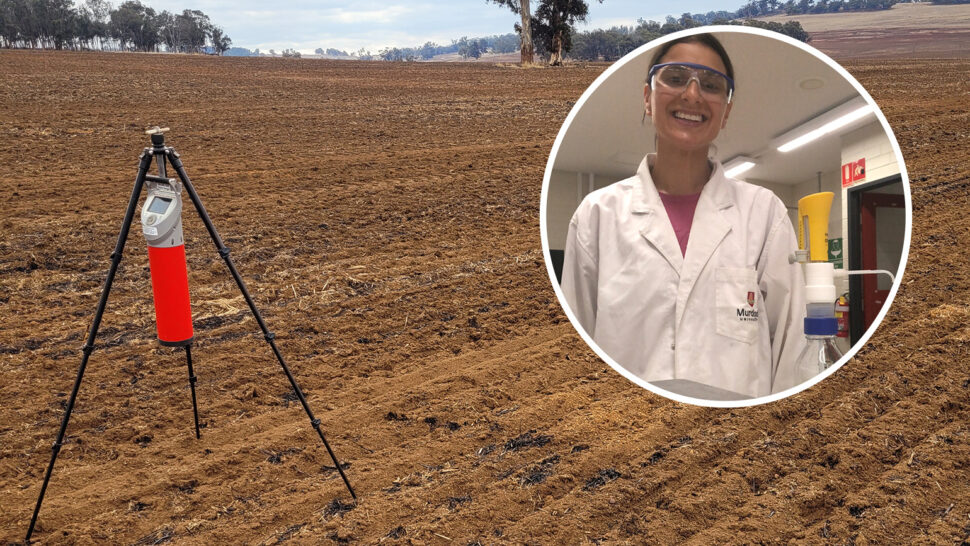Soil CRC PhD student Maria Then’s connection with the natural world was fostered by family hiking trips through southern Australia’s rugged landscape—exploring the Flinders Ranges and the Grampians and discovering their beauty.
“My interest in these landscapes led me to pursue undergraduate studies in geology and geophysics, where I had the opportunity to participate in numerous field trips that deepened my curiosity with the environmental processes that created these incredible places,” Maria said.
“I’m inspired by the complexity and hidden beauty of the natural world, especially the soil beneath our feet, which supports all life yet often goes unnoticed.
“I love that through science, we can uncover how these systems work and apply that knowledge to solve real-world problems. There’s something immensely rewarding about exploring a world that’s always been there, just waiting to be understood.”
Maria’s professional and academic experiences have continued to shape her passion for understanding environmental systems, ultimately guiding her toward a PhD in agricultural science with the Soil CRC.
Her PhD research is part of a Soil CRC project and falls under Program 2 – Soil performance metrics.
“My research focused on soil water repellency (SWR) and the use of proximal soil sensors to better understand and manage this issue,” Maria explained.
Soil water repellency, or hydrophobicity, refers to a soil’s reduced ability to absorb and retain water, often due to waxy organic compounds coating soil particles, leading to water beading or pooling on the surface instead of infiltrating. It is particularly an issue in Western Australia, resulting in non-wetting sands, and ultimately leading to reduced yields in crops.
“The aim was to understand how these soil sensors can assess both the current and future risk of SWR to optimise remediation strategies in sandy soils under dryland cropping systems in Western Australia.”
Maria’s research assessed SWR at different spatial scales (regional, farm, and paddock-scale), and found that predicting SWR using proximal sensors can be difficult and inconsistent.
“Ultimately, I found that accurate prediction of SWR using pedotransfer functions and soil sensors (vis-NIR spectroscopy, gamma, and electromagnetic induction) depends on including both soil and climate variables.
“Gamma radiometrics, EMI, and vis-NIR models performed poorly across different sites for predicting SWR. This indicated that generalised models are not effective, and that locally calibrated models using site-specific soil and climate data are necessary for reliable SWR prediction and mapping across various scales.”
Maria’s research is currently being further tested on farms in Western Australia using both gamma and electromagnetic surveys and on a diverse range of soils.
“By improving the prediction of SWR through proximal sensing and modelling approaches, this work aims to support the development of more accurate and scalable SWR assessment maps,” Maria said.
“These tools can help farmers and land managers make more informed decisions about soil management, leading to more targeted interventions, and ultimately better productivity and sustainable outcomes on repellent soils.”
Maria submitted her thesis late last year and it was passed without corrections, with the examiners indicating that it was within the top 10% of theses they had examined.
“I’m incredibly proud of this achievement, as well as becoming the first in my family to be awarded a PhD,” she said.
“I am fortunate to have had a fantastic PhD journey, one that would not have been possible without a strong support network, particularly my friends and family and my wonderful husband, who completed his own PhD alongside me. It has been a shared adventure!”
Maria credited her principal supervisor, Professor Richard Harper from Murdoch University, for encouraging her to think deeper about science and discover her passion for soil science and agriculture.
“I’m grateful for Professor Harper’s exceptional mentorship and guidance,” she said. “I’m also thankful for the opportunity to learn from and collaborate with my co-supervisors, Professor David Henry (Murdoch University) and Dr Craig Lobsey (University of Southern Queensland), who provided unwavering support and insightful feedback throughout my PhD.
“I feel very lucky to have completed a PhD with the Soil CRC—it provided me with the invaluable opportunity to attend conferences, connect with fellow PhD students from across the country, and engage with academics and stakeholders in the field.
“Additionally, the chance to collaborate with farming groups in Western Australia was a remarkable experience. It was a privilege to work alongside farmers to understand the many soil constraints they face, particularly with the challenges of soil and food security.”
With her PhD behind her, Maria is preparing papers for publication to share her research findings with the broader academic and professional communities.
Excitingly, she has also joined KPMG’s Climate Change and Sustainability team, focussing on areas such as climate risk assessments, gap assessments, and climate scenario analysis.
When she’s not in the office or out in the field, you’ll find Maria rock climbing with her husband and friends as she continues to explore the landscapes she loves.
“I’m grateful to work in a field that I’m passionate about and to be able to do what I love every day—whether at work or at play.”
Find out more
- Read Maria’s research publication: Then, M., Lobsey, C., Henry, D. J., Sochacki, S. J., & Harper, R. J. (2024). Proximal sensing in soil water repellency management: A review. In A.E. Hartemink & J. Juang (Eds.), Progress in soil science: Sandy soils (pp.75-88). Springer. https://doi.org/10.1007/978-3-031-50285-9
- Connect with Maria on LinkedIn

